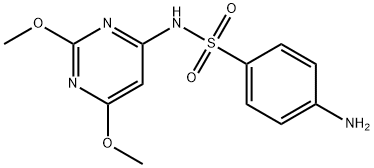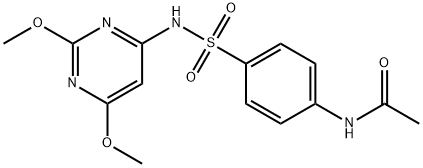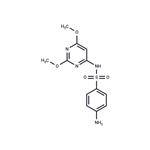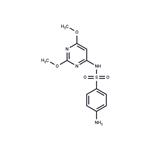Brand Name(s) in US
Albon, Bactrovet, and generic
Chemical Properties
White Solid
Originator
Madribon,Roche,US,1958
Uses
Antibacterial.This compound is a contaminant of emerging concern (CECs).
Definition
ChEBI: A sulfonamide consisting of pyrimidine having methoxy substituents at the 2- and 6-positions and a 4-aminobenzenesulfonamido group at the 4-position.
Manufacturing Process
1.4 g of 4-phenylsulfonyl-2,6-dimethoxypyrimidine and 4 g of sodium
sulfanilamide (both dried over potassium hydroxide) were very finely ground
and heated in an oil bath for 10 hours at 120°C (inside temperature). The
reaction mixture was taken up in 30 ml of water and treated with 3 ml of 2 N
sodium hydroxide solution. After standing for one hour at 0°C, the turbid
solution was filtered and the filtrate was made alkaline with sodium carbonate.
After again standing for one hour at 0°C, the precipitate was filtered off (1.9 g
of regenerated sulfanilamide) and the filtrate was neutralized with acetic acid,
whereupon crystallization resulted. The isolated crystals of 4-sulfanilamido-
2,6-dimethoxypyrimidine weighed 1.3 g (84% of theory), melting point 190°C
to 196°C.
Therapeutic Function
Antibacterial
Pharmaceutical Applications
2,4-Dimethoxy-6-sulfanilamido-1,3-diazine. A rapidly absorbed
compound with a long half-life (38–40 h) and a high degree of
protein binding (98%). Renal clearance is very slow, and daily
dosage maintains adequate plasma levels.
Biological Activity
Sulfonamide antibiotic th at blocks the synthesis of dihydrofolic acid by inhibiting the enzyme dihydropteroate synthase.
Mode of Action: Inhibits folic acid synthesis in prokaryotes.
Anti-microbial Spectrum: Gram positive, Gram negative, Chlamydia
Mode of Resistance: Alteration of dihydropteroate synthase or alternative pathway for folic acid synthesis.
Mechanism of action
The mechanism of action of sulfadimethoxine centres on its ability to inhibit bacterial folic acid synthesis. Folic acid, or folate, is essential for synthesising nucleotides, which are the building blocks of DNA. Sulfadimethoxine acts as a competitive inhibitor of the enzyme dihydropteroate synthase (DHPS). DHPS is crucial for converting para-aminobenzoic acid (PABA) into dihydropteroate, a precursor in folate synthesis. By inhibiting DHPS, sulfadimethoxine prevents the conversion of PABA to dihydropteroate, thereby halting the production of folic acid. Without folic acid, bacteria cannot synthesize the nucleotides necessary for DNA replication, resulting in bacteriostasis – the inhibition of bacterial growth and multiplication. This action is particularly effective against rapidly dividing bacterial cells, making sulfadimethoxine a potent antibacterial agent.
Side effects
Common but usually not serious side effects include: Reduced appetite, vomiting, loose stools (diarrhea).
Side effects that may be serious orindicate a serious problem:
Dry eye syndrome (keratoconjunctivitis sicca; KCS). Before your dog takes this drug, your veterinarian will wantto measure your dog’s tear production. Signs of dry eye include redness or discharge from the eyes or increased blinking. Difficulty urinating or straining to urinate; blood in urine.
Skin conditions: Sores, skin that appears to be burned, severe itching, loss of fur.
Increased thirst and urination.
Swelling of face.
Lack of energy or appetite, tiredness, fever.
Difficulty walking. Yellowing of the gums or whites of the eyes (jaundice).
Safety Profile
Moderately toxic by intraperitoneal, intravenous, and subcutaneous routes. An experimental teratogen. Experimental reproductive effects. When heated to decomposition it emits toxic fumes of SOx and NOx.
Veterinary Drugs and Treatments
Sulfadimethoxine injection and tablets are approved for use in dogs
and cats for respiratory, genitourinary, enteric and soft tissue infections
caused by susceptible organisms. Sulfadimethoxine is used in
the treatment of coccidiosis in dogs although not approved for this
indication.
In horses, sulfadimethoxine injection is approved for the treatment
of respiratory infections caused by Streptococcus equi.
In cattle, the drug is approved for treating shipping fever complex,
calf diphtheria, bacterial pneumonia and foot rot caused by
susceptible organisms.
In poultry, sulfadimethoxine is added to drinking water to treat
coccidiosis, fowl cholera, and infectious coryza.





